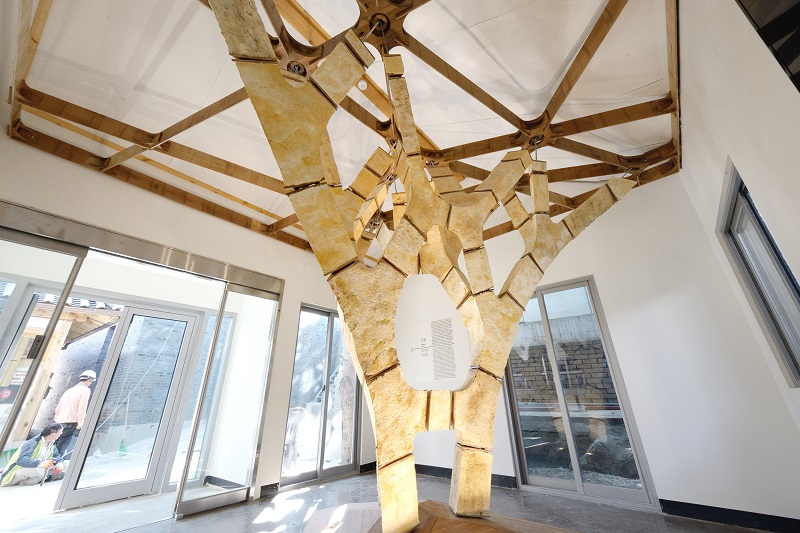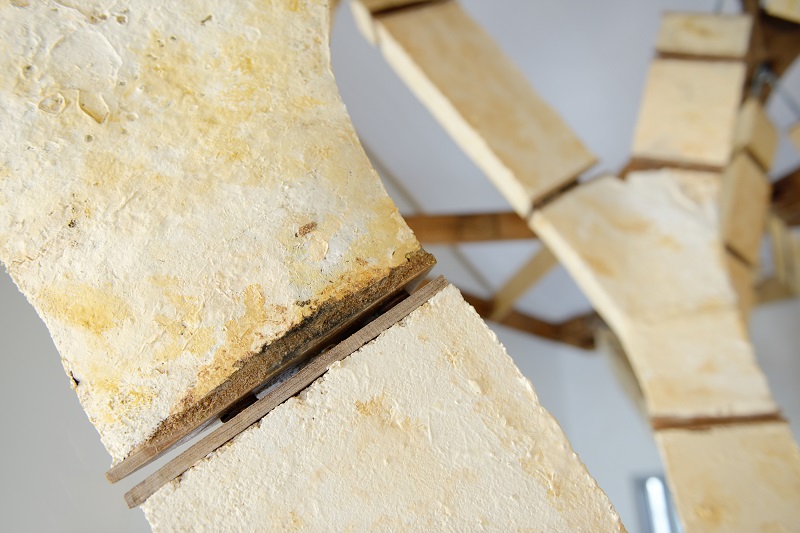Mycelium
Mycelium is the root network of mushrooms, a fast-growing matrix that has the capability of acting as a form of natural glue.
In September 2017, MycoTree was unveiled at the Seoul Biennale for Architecture and Urbanism. MycoTree is a naturally-grown spatial branching structure comprising load-bearing mycelium components and bamboo. It has been developed in response to the need for new and alternative materials and approaches to construction.
According to the developers, materials that were previously considered unwanted and low-strength may offer possibilities for tackling the unsustainable nature of many of the industry’s most popular materials.
The manufacturing process works by mixing a sterilised substrate with mycelium tissue. Over several days, the fungi digests and transforms the nutrients into a dense interlocking matrix of mycelium filaments. This mass can then be cast into digitally-fabricated moulds, which densify into the final shape. The growing process is then halted by drying.
The material can be grown locally, close to the site where it will be used, and, the mycelium absorbs carbon. In addition, it allows for the composting of building elements or whole constructions after usage.
While mycelium-based materials offer significant ecological advantages, they have relatively low structural strength. As with MycoTree, achieving stability through geometry rather than through material strength opens up further possibilities of using weak materials. 'Good' geometry enables the maintaining of equilibrium through compression when building with materials that are weak in tension and bending.
MycoTree is the result of a collaboration between the Professorship of Sustainable Construction at Karlsruhe Institute of Technology (KIT) and the Block Research Group at the Swiss Federal Institute of Technology (ETH) Zürich. It is the centrepiece of the “Beyond Mining – Urban Growth” exhibition at the Seoul Biennale of Architecture and Urbanism 2017 in Seoul, South Korea, and will be on display from September 1st - November 5th 2017.
Team:
- Sustainable Construction, Karlsruhe Institute of Technology: Karsten Schlesier, Felix Heisel, Dirk Hebel
- Block Research Group, ETH Zürich: Juney Lee, Matthias Rippmann, Tomás Méndez Echenagucia, Andrew Liew, Noelle Paulson, Tom Van Mele, Philippe Block
- Alternative Construction Materials, Future Cities Laboratory, Singapore-ETH Centre: Nazanin Saeidi, Alireza Javadian, Adi Reza Nugroho, Robbi Zidna Ilman, Erlambang Adjidarma, Ronaldiaz Hartantyo, Hokie Christian, Orion Tan, Sheng Yu, Kelly Cooper
Production partner:
- Mycotech, PT Miko Bahtera Nusantara, Indonesia
- ETH Global
- ETH Zürich - Department of Architecture
- Karlsruhe Institute of Technology (KIT)
- Future Cities Laboratory (FCL) - Singapore-ETH Centre
Content and images courtesy of ETH Zurich.
[edit] Find out more
[edit] Related articles on Designing Buildings Wiki
Featured articles and news
RTPI leader to become new CIOB Chief Executive Officer
Dr Victoria Hills MRTPI, FICE to take over after Caroline Gumble’s departure.
Social and affordable housing, a long term plan for delivery
The “Delivering a Decade of Renewal for Social and Affordable Housing” strategy sets out future path.
A change to adoptive architecture
Effects of global weather warming on architectural detailing, material choice and human interaction.
The proposed publicly owned and backed subsidiary of Homes England, to facilitate new homes.
How big is the problem and what can we do to mitigate the effects?
Overheating guidance and tools for building designers
A number of cool guides to help with the heat.
The UK's Modern Industrial Strategy: A 10 year plan
Previous consultation criticism, current key elements and general support with some persisting reservations.
Building Safety Regulator reforms
New roles, new staff and a new fast track service pave the way for a single construction regulator.
Architectural Technologist CPDs and Communications
CIAT CPD… and how you can do it!
Cooling centres and cool spaces
Managing extreme heat in cities by directing the public to places for heat stress relief and water sources.
Winter gardens: A brief history and warm variations
Extending the season with glass in different forms and terms.
Restoring Great Yarmouth's Winter Gardens
Transforming one of the least sustainable constructions imaginable.
Construction Skills Mission Board launch sector drive
Newly formed government and industry collaboration set strategy for recruiting an additional 100,000 construction workers a year.
New Architects Code comes into effect in September 2025
ARB Architects Code of Conduct and Practice available with ongoing consultation regarding guidance.
Welsh Skills Body (Medr) launches ambitious plan
The new skills body brings together funding and regulation of tertiary education and research for the devolved nation.
Paul Gandy FCIOB announced as next CIOB President
Former Tilbury Douglas CEO takes helm.
UK Infrastructure: A 10 Year Strategy. In brief with reactions
With the National Infrastructure and Service Transformation Authority (NISTA).
























